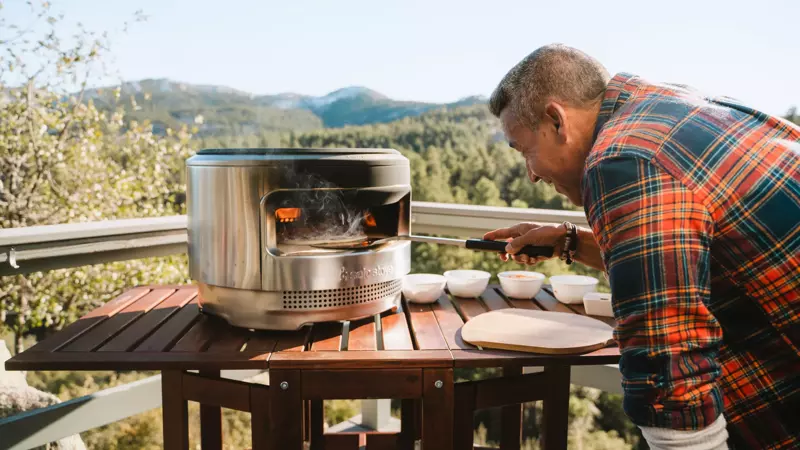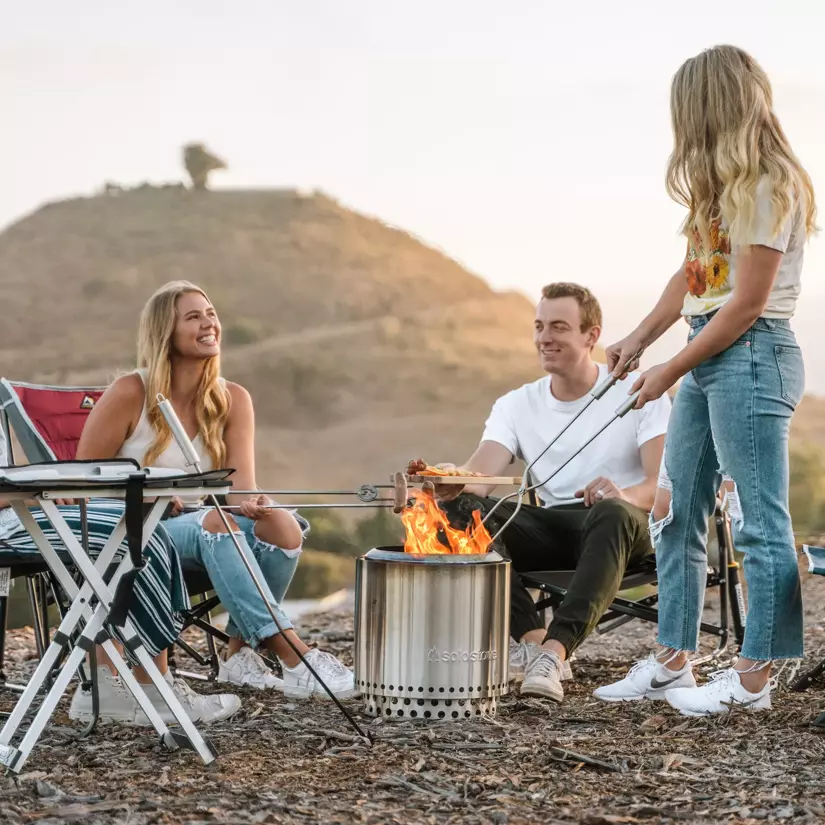Cooking a Gourmet Campfire Meal with Solo Stove
If you like cooking over an open fire, then one of the best parts about camping is the food. Whether you love making thick ribeye steaks, roasting fish and veggies, or just getting the perfectly golden marshmallow ready for s’mores, nothing beats cooking with fire.
We recently sat down with Solo Stove on one of our latest Launching Life’s Journeys podcast. What started as a Kickstarter campaign in 2010 to bring a single product to market has become a company that provides fire pits, pizza ovens, camp stoves, and more in a variety of sizes. And we know that many Heartland owners never leave home without their Solo Stove, so today, let’s break down how to cook a gourmet campfire meal with them to make your next camp meal the best yet.
Getting Started with Solo Stove
Before we delve into meal ideas and cooking techniques, let's first understand what makes the Solo Stove special. Their innovative design burns wood efficiently, and thanks to clever airflow, you’ll get a nearly smokeless cooking experience. They’re lightweight and easy to transport and come in a range of sizes, so you can cook for one or ten with ease.
Essential Campfire Cooking Gear
Just like at home, you’ll want to have the right tools for the job. Choose versatile cookware that can withstand open flames, and look for lightweight accessories that are easy to pack and carry. Cast iron skillets and Dutch ovens are camping classics because they’re nearly indestructible and can always be brought back to life, even when they’re in rough shape. They hold heat evenly and work great over an open fire with the addition of a metal grate, and they’ll last you a lifetime. Solo also offers a line of cooking accessories, which include griddle tops and grills, and even pizza ovens and woks. When it comes to smaller accessories, tongs, roasting forks, spatulas, grill baskets, and heat-resistant gloves will give you a good start to cook just about anything you like.
Campfire Firewood
You’ll also need to buy or bring some firewood. If you’re traveling out of your local region or state, plan on buying firewood when you get close to your campsite. In the last few decades, there have been various invasive species of bugs and fungi that can wreak havoc on local ecosystems, destroying trees and killing off beneficial local insects. You may have heard of the Emerald Ash Borer, an insect native to Asia that was first spotted in Michigan in 2002. It’s now spread to 30 different states and has left a trail of dead trees in its wake.

What firewood is good for cooking? Typically, hardwoods like oak, hickory, and cedar make beautiful campfires. The dense wood burns more slowly and evenly than softwoods like pine or aspen, which can burn hot and fast. For cooking, a slower, steadier burn is preferable. And some woods have traditionally been paired with specific foods, the way we pair wine and cheese, to enhance the flavor of the food with the scent of the wood smoke. For example, pork tastes great cooked with applewood, salmon pairs well with cedar, and mesquite is a classic for cooking chicken.
Prepare Ahead of Time
Before you leave on your trip, take some time to prepare your meals and menu in advance, along with how much firewood you’ll need and what kind of accessories you’ll need to bring. Make backup plans for any meals that can’t be replicated or won’t be as good indoors, just in case the weather is bad or you’re in a place that has a fire ban in place when you get there.
This is also a good time to plot out any locations near your destination that sell particularly high-quality or fresh foods – like farm stands, farmers’ markets, orchards, small dairy farms, and anywhere that sells meat or eggs from animals they raise themselves. Not only are they a fun way to get familiar with the area, but they often offer cuts of meat or products you can’t find in commercial grocery stores.
Make Your Fire
There are dozens of different ways to build campfires, whether you want a blaze that lasts just a few hours, one that puts out a decent amount of heat in cold weather, or one that’s small and perfect for roasting marshmallows. For cooking, we want a steady, even source of heat that will stay predictable for the duration of the time we need to cook our food.
To set up a fire in your Solo Stove, they’ve provided solid fire-building instructions for how to lay a foundation, add fire starters, and arrange your wood in a way that makes the most of the stove itself.
Campfire Cooking Techniques
There are several different methods of cooking over a campfire, all of which you can do with the Solo Stove. You can cook food directly over open flames, use a griddle or grill directly over open flames, put a grate down and cook inside a skillet or Dutch oven, or use another accessory like the Solo pizza oven.
Cooking over open flames can include things like using skewers or sticks to roast hot dogs or brats, grill corn, and toast marshmallows. This can be a fun way to include kids in cooking or make meal prep into a group activity – but if you’re cooking for a crowd or it’s really hot out, it can also be a bit of a pain because you have to stand close to the fire.
Adding a Griddle or Grill
If you add a griddle or grill over your flames, you open up a new realm of cooking possibilities. Now, you have a flat surface just like your home stove or a gas grill. You can roast vegetables, bake potatoes, sear steaks, grill fish, scramble eggs, and even make a stack of pancakes. The key to cooking well with a griddle or grill pan is to let it heat up over the flames before you add your food, which will help the food cook quickly and not stick to the pan. For something like a thick steak, you’ll want a screaming hot surface to help you sear the outer surfaces. For pancakes or French toast, you don’t need quite as much heat, but you’ll want to make sure it’s even and steady.
Adding a metal grate over your flames gives you even more cooking options. Now, you can roast a wider variety of foods over an open flame, like fish and veggies in foil packets, hamburgers, or cuts of chicken. If you love making any kind of kebabs at home, a metal grate is an ideal surface for cooking them over an open flame, offering plenty of support but allowing the flames to crisp up the corners and impart a delicious smoky flavor.
Other Campfire Cooking Accessories

On top of a metal grate, you can also add a cast iron pan or Dutch oven. Unlike griddle or grill tops, you can use them to boil water or heat oil for frying. Now you’ve got what you need to make hard-boiled eggs for egg salad, whip up a batch of your famous fried chicken, or cook a big batch of hearty chili and cornbread.
Finally, with Solo Stove brand accessories like the pizza oven or the cast iron wok, you can easily recreate your family’s specific favorite meals. Whether your kids love homemade Hawaiian-style pizza or beef with broccoli, you’ll be able to dazzle them with your skill cooking over an open flame.
Cooking Tips
While home stoves and ovens can maintain a consistent temperature for hours at a time, cooking with fire can be less predictable. Just remember that humans have been cooking with fire for millennia, and a lack of predictability doesn’t mean you can’t get a great result.
If you’re trying to convert a traditional recipe, take its cooking temperature with a grain of salt. You don’t need a perfect 375-degree heat source to roast potatoes. A heat source that’s a bit hotter or cooler will work just as well; all you have to do is adjust the time and keep an eye on it. While baking is more precise and scientific, cooking and grilling are more like an art, with lots of different options for getting a wonderful result.
We would also recommend that you get a good feel for both your Solo Stove and the type of firewood you prefer using before testing out any really expensive foods. See how hot your fire gets the way you like to build it and cook something more forgiving to adjust your technique. A few crispy sausages will save you the grief of over-charring a tomahawk steak or a fancy side of swordfish.
Clean-Up and Maintenance
Long after you’ve enjoyed your delicious meal and the fire has burned itself out, empty the cold ashes and any leftover wood from the burn chamber. You don’t necessarily need to empty your ashes every time you cook, but keeping your Solo Stove clean will help it cook more evenly and efficiently. To empty the ashes, you can just tip the stove over and let them fall out, or vacuum them out with a shop vac. Don’t use a hose to clean ashes out of your Solo Stove, as the water can cause the ash to clog the air intake holes and reduce the performance of your stove over time.
And after each trip, wipe your Solo Stove down with a soft, damp rag to keep soot from accumulating. The stainless steel of the stove may change color after its first few uses. This is a normal patina, but if it bothers you, you can remove it by scrubbing it with Bar Keeper’s Friend in the direction of the stainless steel grain.
Leave No Trace Principles
As responsible campers, it's essential to leave nature as we found it. Practicing Leave No Trace principles is crucial for preserving the beauty of our natural landscapes. Properly dispose of food waste and ashes, which may include carrying them out with you when you leave your campsite. Always follow local regulations for campfires. Leave only footprints and memories, not trash.

Campfire Cooking Safety
It’s important to practice good cooking safety principles when you’re cooking with fire. Set your Solo Stove up in a safe location, away from overhanging trees, dry brush, or other flammable materials. Use the Solo Stove Stand to raise your stove off the ground when necessary, such as on grass, decking, and other turf. A pair of heat-resistant gloves can help you handle the stove as necessary when it has an active fire, and you should always keep a bucket of water or sand nearby for emergencies. Practicing these safety measures can help ensure your camping experience is memorable for the right reasons – and not because disaster happened.
Now that you’re equipped with the knowledge and skills you need to master campfire cooking with Solo Stove, you’re ready to go. So gather your gear, pick your favorite recipes, and head into the wilderness. We know you’ll have a great time cooking all your favorite foods, making wonderful memories, and spending time with the people you love. Happy camping and happy cooking!





